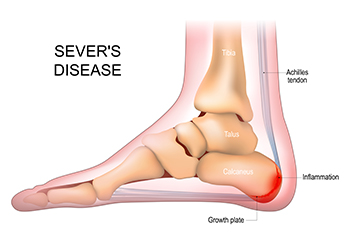
Sever's disease is a common source of heel discomfort during childhood and early adolescence, particularly among active children engaged in running and jumping activities. This condition arises from strain on the heel bone caused by the calf muscle tendon's attachment. Children might experience limping and pain during various activities, affecting one or both feet. While there is no specific remedy for Sever’s disease, symptoms can be managed. Temporarily discontinuing the triggering activity, opting for comfortable shoes with heel inserts, and engaging in daily calf stretches can provide relief. Typically, pain subsides within 6 to 12 months, though it may persist for up to two years. The condition should not have long-term effects. If a child complains of heel pain, it is suggested that you make an appointment with a chiropodist for a proper diagnosis and treatment.
Sever’s disease typically affects young children and teenagers. If your child complains of foot pain, please consult with one of the chiropodists from Complete Family Footcare & Therapy. Our clinicians will assess your condition and provide you with quality foot and ankle treatment.
What Is Sever’s Disease?
Sever’s disease, also known as calcaneal apophysitis, is an inflammation of the growth plate in the heel bone. It is typically caused by overuse due to repetitive activities such as running, jumping, and playing certain sports. This condition most frequently affects children between the ages of 8 and 14.
Symptoms
Symptoms of Sever’s disease include:
Pain in the back or bottom of the heel
Pain when the sides of the heel are squeezed
Limping or walking on tiptoes to avoid putting pressure on the heel
Difficulty running, jumping, or participating in usual activities
Fatigue
Diagnosis
Sever’s disease is diagnosed by taking a thorough medical history and performing a physical examination. Imaging studies, such as an X-ray, can help rule out other injuries like a fracture.
Treatment
Sever’s disease typically heals without any long-term complications. Treatment involves resting the affected foot by reducing typical activities, wearing orthotics to support the foot, immobilizing the affected foot, taking medications to reduce pain and inflammation, and stretching the foot.
If you have any questions, please feel free to contact our offices located in . We offer the newest diagnostic and treatment technologies for all your foot care needs.
